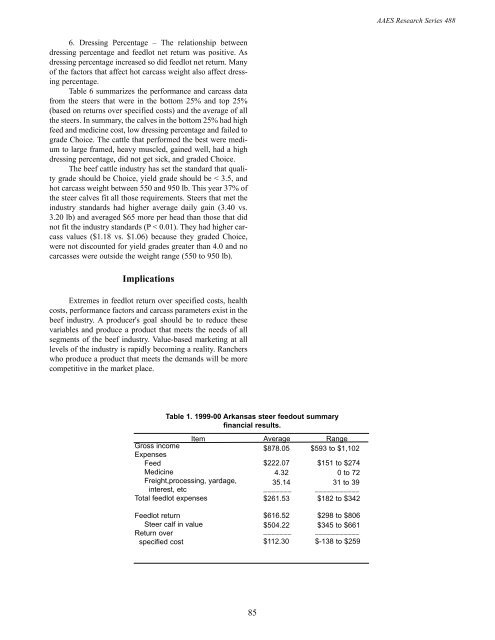Arkansas - Agricultural Communication Services - University of ...
Arkansas - Agricultural Communication Services - University of ...
Arkansas - Agricultural Communication Services - University of ...
You also want an ePaper? Increase the reach of your titles
YUMPU automatically turns print PDFs into web optimized ePapers that Google loves.
AAES Research Series 488<br />
6. Dressing Percentage – The relationship between<br />
dressing percentage and feedlot net return was positive. As<br />
dressing percentage increased so did feedlot net return. Many<br />
<strong>of</strong> the factors that affect hot carcass weight also affect dressing<br />
percentage.<br />
Table 6 summarizes the performance and carcass data<br />
from the steers that were in the bottom 25% and top 25%<br />
(based on returns over specified costs) and the average <strong>of</strong> all<br />
the steers. In summary, the calves in the bottom 25% had high<br />
feed and medicine cost, low dressing percentage and failed to<br />
grade Choice. The cattle that performed the best were medium<br />
to large framed, heavy muscled, gained well, had a high<br />
dressing percentage, did not get sick, and graded Choice.<br />
The beef cattle industry has set the standard that quality<br />
grade should be Choice, yield grade should be < 3.5, and<br />
hot carcass weight between 550 and 950 lb. This year 37% <strong>of</strong><br />
the steer calves fit all those requirements. Steers that met the<br />
industry standards had higher average daily gain (3.40 vs.<br />
3.20 lb) and averaged $65 more per head than those that did<br />
not fit the industry standards (P < 0.01). They had higher carcass<br />
values ($1.18 vs. $1.06) because they graded Choice,<br />
were not discounted for yield grades greater than 4.0 and no<br />
carcasses were outside the weight range (550 to 950 lb).<br />
Implications<br />
Extremes in feedlot return over specified costs, health<br />
costs, performance factors and carcass parameters exist in the<br />
beef industry. A producer's goal should be to reduce these<br />
variables and produce a product that meets the needs <strong>of</strong> all<br />
segments <strong>of</strong> the beef industry. Value-based marketing at all<br />
levels <strong>of</strong> the industry is rapidly becoming a reality. Ranchers<br />
who produce a product that meets the demands will be more<br />
competitive in the market place.<br />
Table 1. 1999-00 <strong>Arkansas</strong> steer feedout summary<br />
financial results.<br />
Item<br />
Gross income<br />
Expenses<br />
Feed<br />
Medicine<br />
Freight,processing, yardage,<br />
interest, etc<br />
Total feedlot expenses<br />
Feedlot return<br />
Steer calf in value<br />
Return over<br />
specified cost<br />
Average Range<br />
$878.05 $593 to $1,102<br />
$222.07 $151 to $274<br />
4.32 0 to 72<br />
35.14<br />
_______<br />
31 to 39<br />
___________<br />
$261.53 $182 to $342<br />
$616.52 $298 to $806<br />
$504.22<br />
_______<br />
$345 to $661<br />
___________<br />
$112.30 $-138 to $259<br />
85

















